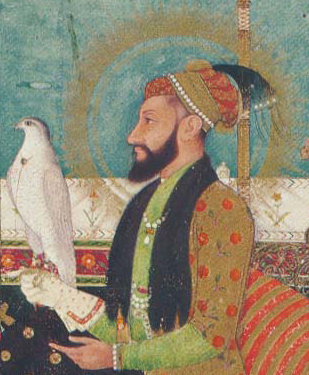
Muhi al-Din Muhammad, commonly known as Aurangzeb, was the sixth Mughal emperor, reigning from 1658 until his death in 1707. His regnal name is Alamgir I, which derived from his title, Abu al-Muzaffar Muhi-ad-Din Muhammad Bahadur Alamgir Aurangzeb Badshah al-Ghazi. Under his emperorship, Mughal Empire reached its greatest extent with territory spanning nearly the entirety of the Indian subcontinent.

Sambhaji, also known as Shambhuraje, was the second Chhatrapati of the Maratha Empire, ruling from 1681 to 1689. He was the eldest son of Shivaji, the founder of the Maratha Kingdom. Sambhaji's rule was largely shaped by the ongoing wars between the Marathas and the Mughal Empire, as well as other neighbouring powers such as the Abyssinians of Janjira, Wadiyars of Mysore and the Portuguese Empire in Goa. After Sambhaji's execution by Aurangzeb, his brother Rajaram I succeeded him as the next Chhatrapati and continued the Mughal–Maratha Wars.

Mir Qamar-ud-din Khan Siddiqi also known as Chin Qilich Qamaruddin Khan, Nizam-ul-Mulk, Asaf Jah and Nizam I, was the first Nizam of Hyderabad.
Moropant Trimbak Pingale (1620–1683), was the first peshwa of the Maratha Empire, serving on Shivaji Maharaj's Ashta Pradhan.

Shahu I was the fifth Chhatrapati of the Maratha Confederacy founded by his grandfather, Shivaji I. He was born into the Bhonsle family, and was the son of Sambhaji I and Yesubai. At a young age, he was taken into custody at the Siege of Raigad by Mughal emperor Aurangzeb, and held captive. He was released from captivity after the death of Aurangzeb in the hope of engineering an internecine struggle among the Maratha factions of Tarabai and Shahu. Shahu emerged victorious in the bloody Battle of Khed and was crowned as Chhatrapati.

Balaji Vishwanath Bhat was the first of a series of hereditary Peshwas hailing from the Bhat family who gained effective control of the Maratha Confederacy and other Mughal vassals during the early 18th century. Balaji Vishwanath assisted a young Maratha king Shahu to consolidate his grip on a kingdom that had been racked by civil war and persistently intruded on by the Mughals under Aurangzeb. He was called the Second Founder of the Maratha State. He secured a grant from the Mughal court that confirmed Shahu as the legitimate Mughal vassal, at the expense of his rival Sambhaji II. Later, his son Bajirao I became the Peshwa.
Hansaji Mohite (1630–1687), popularly known as Hambir Rao Mohite, was a prominent Maratha general who held the esteemed position of the 5th Senapati of the Maratha Army during the reign of Chhatrapati Shivaji Maharaj. He was recognized for his exceptional military prowess and successfully led various campaigns on behalf of Chhatrapati Shivaji Maharaj, subsequently continuing his service under Chhatrapati Sambhaji Maharaj.

The Deccan wars were a series of military conflicts between the Mughal Empire and the descendants of the Maratha ruler Shivaji from the time of Shivaji's death in 1680 until the death of Emperor Aurangzeb in 1707. Shivaji was a central figure in what has been called "the Maratha insurgency" against the Mughal state. Both he and his son, Sambhaji, or Shambuji, typically, alternated between rebellion against the Mughal state and service to the Mughal sovereign in an official capacity. It was common practice in late 17th-century India for members of a ruling family of a small principality to both collaborate with the Mughals and rebel.

Mirza Abu Talib, better known as Shaista Khan, was a Moghul General and the Subahdar of Mughal Bengal, he was maternal uncle to the Mughal Emperor Aurangzeb, he acted as a key figure during his reign, Shaista Khan initially governed the Deccan, where he clashed with the Maratha ruler Shivaji, However, he was most notable for his tenure as the governor of Bengal from 1664 to 1688, Under Shaista Khan's authority, the city of Dhaka and Mughal power in the province attained its greatest heights. His achievements include constructions of notable mosques such as the Sat Gambuj Mosque and masterminding the conquest of Chittagong. Shaista Khan was also responsible for sparking the outbreak of the Anglo-Mughal War with the English East India Company.
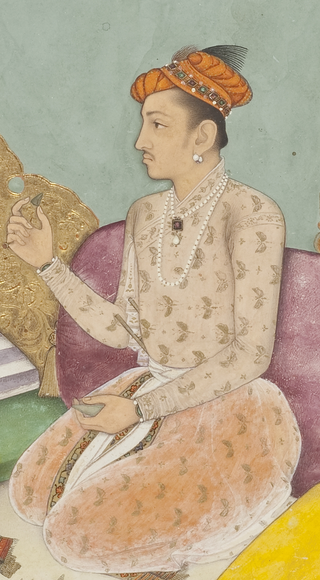
Mirza Raja Jai Singh I was the senior most general and a high ranking mansabdar at the imperial court of Mughal Empire as well as the Kachwaha ruler of the Kingdom of Amber. His predecessor was his grand uncle, Mirza Raja Bhau Singh, the younger son of Mirza Raja Man Singh I.

The siege of Bijapur began in March 1685 and ended in September 1686 with a Mughal victory. The siege began when Aurangzeb dispatched his son, Muhammad Azam Shah, with a force of nearly 50,000 men to capture Bijapur Fort and defeat Sikandar Adil Shah, the then ruler of Bijapur, who refused to be a vassal of the Mughal Empire. The siege of Bijapur was among the longest military engagements of the Mughals, lasting more than 15 months until Aurangzeb personally arrived to organize a victory.
The Battle of Salher was fought between the Marathas and the Mughal Empire in February 1672 CE. The battle was fought near the fort of Salher in modern-day Nashik district. The result was a decisive victory for the Marathas. This battle is considered particularly significant as it is the first pitched battle where the Mughal Empire lost to the Marathas.

The Maratha Navy was the naval wing of the armed forces of the Maratha Confederacy, which existed from around the mid-17th century to the mid-18th century in the Indian subcontinent.

Tomb of Khan-e-Jahan Bahadur Kokaltash is a 17th-century tomb of a Mughal governor that is located in Mohalla Ganj, in the Pakistani city of Lahore.
Fidai Khan Koka, Governor of Awadh, Lahore and master of ordnance and foster brother to the Mughal Emperor Aurangzeb, Aurangzeb had two foster-brothers, Fida and Bahadur Khan, which was Aurangzeb's favourite. Fidai Khan was credited with leading construction on the Persian Gardens known as Pinjore Gardens near Chandigarh, which is the post-partition capital of Punjab, as well as building Teele Wali Masjid (1658–1660) of Lucknow, India and Badshahi Mosque (1671–1673) of Lahore.
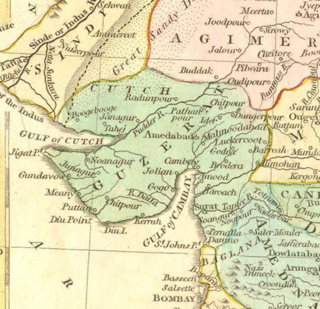
The Gujarat Subah was a province (subah) of the Mughal Empire, encompassing the Gujarat region. The region first fell under Mughal control in 1573, when the Mughal emperor Akbar defeated the Gujarat Sultanate under Muzaffar Shah III.
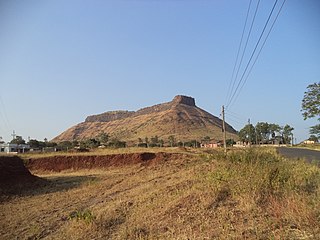
Siege of Ramsej was a series of military confrontations between the Maratha Empire headed by Sambhaji and the Mughal Empire led by Aurangzeb regarding the control of Ramsej Fort in the Nashik region. Aurangzeb arrived in the Deccan in late 1681 with a strong army to destroy the Maratha Empire and the Deccan Sultanates of Adilshahi and Qutubshahi. He wanted to capture the forts held by the Marathas in the Nashik and Baglana regions. Hence he decided to begin his Deccan campaign with an attack on Ramsej Fort which is near Nashik. The Mughal forces under Kasim Khan Kirmani captured Ramsej from the Marathas. The defending Maratha forces evacuated the fort.
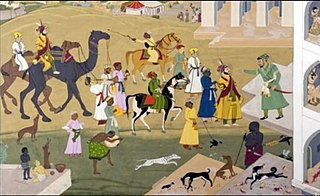
The Execution of Sambhaji was a significant event in 17th-century Deccan India, where the second Maratha King was put to death by order of the Mughal emperor Aurangzeb. The conflicts between the Mughals and the Deccan Sultanates, which resulted in the downfall of the Sultanates, paved the way for tensions between the Marathas and the Mughals. Following the death of Shivaji, his son Sambhaji ascended to the throne and conducted several campaigns against the Mughals. This led Aurangzeb to launch a campaign against the Marathas, resulting in the capture of the Maratha King by the Mughal general Muqarrab Khan. Sambhaji and his minister Kavi Kalash were then taken to Tulapur, where they were tortured to death.
Khwaja Kamal, commonly known as Iwaz Khan, was a Turani Mughal leader who served as the last Subahdar of the Berar Subah under the Mughal empire. He also held the distinction of being the first Dewan of the Nizam of Hyderabad.
The Battle of Kalyan Bhivandi was fought between Maratha Forces of Sambhaji and The Mughal forces under Bahadur Khan in which latter was defeated and Maratha emerged victorious.














